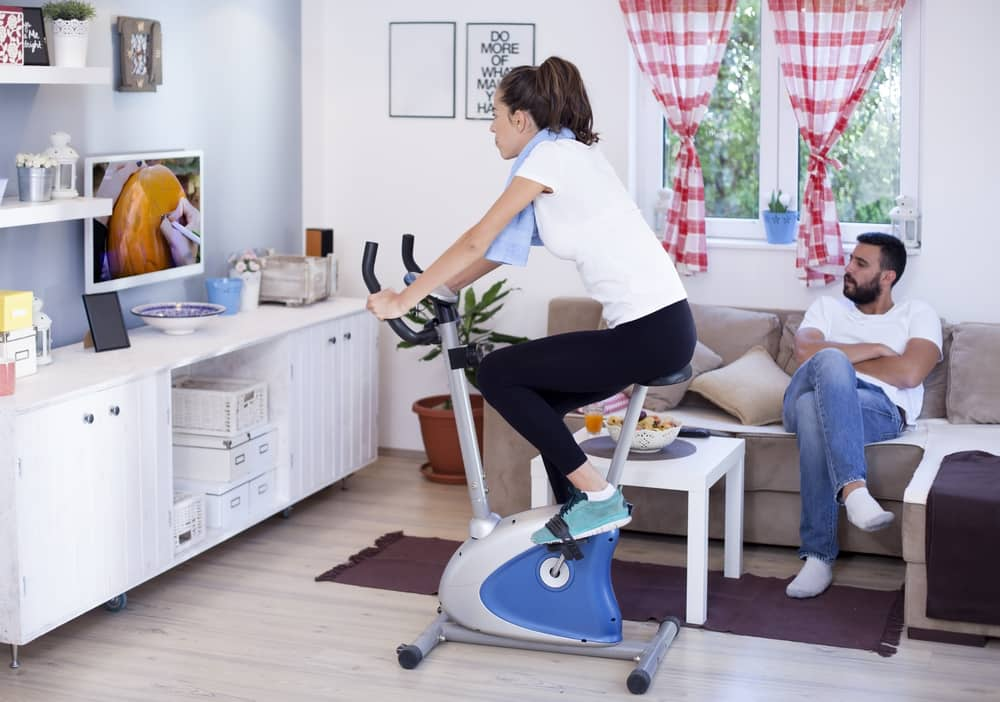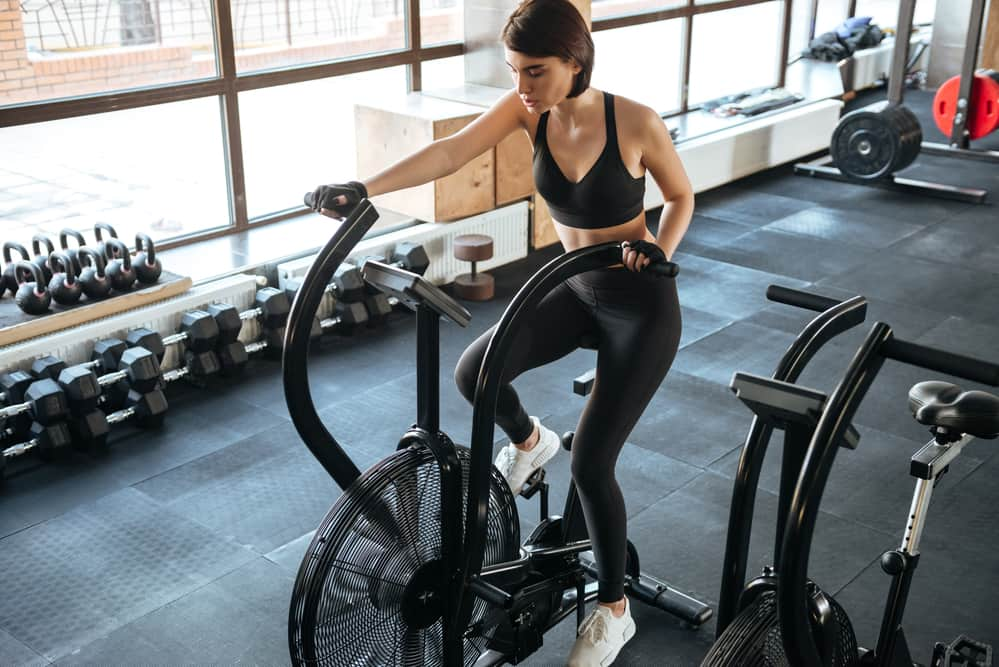All indoor exercise bike types are excellent for giving a good cardio workout. However, some types of exercise bikes have features that match your fitness goals better.
Let’s identify all 4 exercise bike types and see which one fits your goals and personal preference best.
Different Types of Exercise Bikes
The most common types of exercise bikes include the spin, upright, air and recumbent.

1. Spin Type: Simplest and Most Compact Exercise Bike
The spin exercise bike is also known as a studio or indoor cycling bike, is a favourite primarily because of its compact and simplistic design.
Most models only have a few parts, including the metal frame, pedals, flywheel, bike seat and handlebars. They usually have minimal electronics, too, making them easy to figure out and relatively light.
Also, you’ll have to turn a knob to adjust the resistance level. This knob connects to the leather or foam pad of the flywheel to increase or reduce friction.
Generally, spin exercise bikes are affordable. However, high-end models with magnetic resistance are also available. For example, the more expensive interactive bikes like the NordicTrack S22i Studio Bike and the Peloton Bike fall in the spin-type category.
Pros
- Realistic riding experience. Spin bikes have the seat and handlebar at almost the same height. This positioning allows you to lean your upper body while pedalling, giving you a feeling similar to outdoor cycling.
- Workout variety. Spin exercise bikes come with a wide range of resistance levels. You can set yours on low for beginner workouts or stand up while cycling at a higher intensity. This flexible feature is perfect for high-intensity interval training (HIIT) and toning specific muscle groups.
- Compact and sturdy construction. Its small footprint makes it easy to move around and ideal for home use. It also has minimal or no plastic components, so it should last long with proper use and maintenance.
Cons
- Uncomfortable saddle. Most spin bikes have narrow and hard bike seats. You’ll probably have to look for a replacement with extra padding to avoid the dreaded sore butt.
- Limited technology. Basic spin bikes usually require manual operation and do not work with compatible apps or gadgets. You have to choose a more modern and expensive model to get these upgrades.
- Continuous flywheel momentum. The pedals of a spin bike continue to turn unless you stop them with your feet. It can be dangerous for curious kids, so you might need to place the equipment somewhere secluded and safe.
See also: How is a Spin Bike Different from a Stationary Bike?

2. Upright Type: Cheapest and Most Beginner-Friendly Exercise Bike
This upright exercise bike is the most common type. Some also call it the home or static exercise bike. The upright bike got its name from your seating position while on this machine.
Its handlebars are typically higher than the bike seat, encouraging you to sit tall while pedalling. You can lower the handlebar but you won’t be able to achieve the same leaning posture as you would with a spin bike.
Compared with the spin bike, an upright exercise bike looks more relaxed, with its padded seat, softer handlebars and plastic shrouding. Upright exercise bikes also come with consoles, where you can control the magnetic resistance and other settings.
Pros
- Beginner-friendly. Compared with hardcore spin bikes, upright ones are more comfortable. They also have consoles for tracking workout progress, which is particularly helpful for newbies.
- Built-in programs. Access to a range of on-screen workouts makes it easy to get started on your indoor cycling workouts. These also ensure that you start and end your routine correctly and safely.
- Easy to adjust. Instead of a knob, users can quickly shift resistance levels by pressing a button. Also, magnetic resistance is more consistent, making it easier to track your stamina development.
- Affordable. Even budget upright exercise bikes can provide a good workout. Still, you would have to spend a little more if you plan to use your bike for intense training.
- Excellent for the muscles. One study published in the International Journal of Sports Physical Therapy shows that cycling in an upright position benefits the quads, particularly the rectus femoris. It also keeps the core engaged.
Cons
- Slightly bulky. Upright bikes are not as compact as spin bikes, so you might want to reconsider if you have a small home gym. Alternatively, you can also opt for a foldable upright bike.
- Unsuitable for outdoor bike training. The upright position does not simulate the proper cycling form you need for outdoor events or competitions.

3. Air Type: Best Full-Body and HIIT Exercise Bike
An air bike is easy to spot because of its distinct spinning fan blade. It works as the flywheel, using air as the source of resistance.
There is no knob or button to press for resistance adjustment so you will have to pedal faster to increase the tension. The effect is exponential, meaning if you pedal twice as fast, the effort must be more than double. It’s an excellent feature for people who prefer tough workouts.
Another thing that makes air bikes unique is their movable handles. It also explains why this type is often called a dual-action bike. Your cycling form is similar to upright bikes. However, air bikes are more versatile as they work great for intense training and steady-state cardio.
Air bikes do not have a lot of plastic shrouding or parts, either. So, they are as easy to move around as spin bikes. However, the large fan wheel can take up space.
Pros
- High maximum resistance. Air bikes have no resistance limit since they depend on your physical input. It’s excellent for encouraging progressive training. It also means this exercise bike type suits any user, no matter their fitness level.
- High workout intensity. Air bikes are easy to use for interval training as you only need to adjust your cycling speed to add or reduce resistance. The addition of the movable handlebars also makes them ideal for full-body workouts.
Cons
- Noisy. The air-based ones are the loudest among all other types of exercise bikes. The harder you pedal, the noisier it is. And if you are in an apartment space, the vibration can affect your neighbours. Also, watching TV or listening to music while working out may be difficult.
- Tedious to maintain. The exposed fan blades are prone to dust build-up. You probably need to clean and maintain them more often to keep your air bike in good condition.

4. Recumbent Type: Most Comfortable Exercise Bike
Among other exercise bike types, the recumbent one is the most distinct. For one, recumbent bikes are longer. Instead of a saddle, they have bike seats with backrests.
The pedals are also closer to the front, allowing you to pedal with slightly stretched-out, rather than bent, legs. There are no handlebars to move or hold onto either. So, you can sit back and relax while working out.
With this machine, you can easily do other tasks, like watching TV or reading a book, while getting optimum biking benefits. Most recumbent bikes also have magnetic resistance that you can easily adjust through the console. Find out what muscles recumbent bikes work in this post.
Pros
- Comfortable. The backrest of a recumbent bike ensures that your upper body gets ample support during workouts. This ergonomic design benefits those with back issues.
- Joint-friendly. Your body will be in a neutral position while on a recumbent bike. That means you won’t be putting as much stress on your joints. It’s also why recumbent machines are ideal for users recovering from an injury or surgery.
- Lower seat position. Seniors or people with mobility problems will not have difficulty getting on and off this bike type.
Cons
- Bulky. Recumbent exercise bikes are longer than other types. They take up more room, so you’ll need a dedicated space for them.
- Lower workout intensity. Recumbent bikes are not for intense training or hovering. Most of the exercise load focuses on the lower body, too. So, it is challenging to get a variety of workouts from these machines.
Conclusion
These 4 types of exercise bikes are excellent for cardio workouts. Some exercise bike types will suit your fitness goal better. For instance, a spin or air bike is the best choice if you need intense workouts for weight loss.
On the other hand, upright bikes are ideal for beginners looking for a more comfortable and budget-friendly option. If you have joint or back issues, you are better off with a recumbent bike.
When choosing an exercise bike, find time to read reviews and guides. That way, you’ll get the exercise bike type and model with the correct features and specs.

Related Questions
1. Which exercise bike type is best for toning the bum?
Choose a spin or upright bike if you want to target your glutes more. Aside from encouraging the correct leaning posture, these bike types allow you to pedal while standing. This hovering technique can significantly improve your bum shape. Also, if possible, find a bike with incline mode, like the NordicTrack Commercial S22i. This feature can easily replicate outdoor cycling and make your glute muscles work harder.
2. Is a belt-driven exercise bike better than a chain drive?
A belt-drive bike is better if you prefer smoother, quiet rides on a low-maintenance machine. However, it won’t give you the realistic riding experience as a chain-driven bike would. I suggest trying out a few units while shopping around. It should help you gauge whether a belt-drive or chain-drive system feels best.
3. What are interactive bikes, and are they better than regular ones?
Smart bikes, like these Peloton bike alternatives, are the high-tech version of regular spin bikes. They are Bluetooth-ready, work with compatible apps and have automated functions. However, these interactive bikes are also more expensive. Standard exercise bikes are just as good. Both smart bikes and regular bikes make excellent substitutes if you have a tight budget or limited home gym space.
- Foldable vs Traditional Reformers: Which One’s Right for You? - 2 July 2025
- Elliptical Cross Trainer vs Exercise Bike: Which is Better? - 24 June 2025
- How Do the Different Massage Gun Attachments Work? - 23 June 2025
